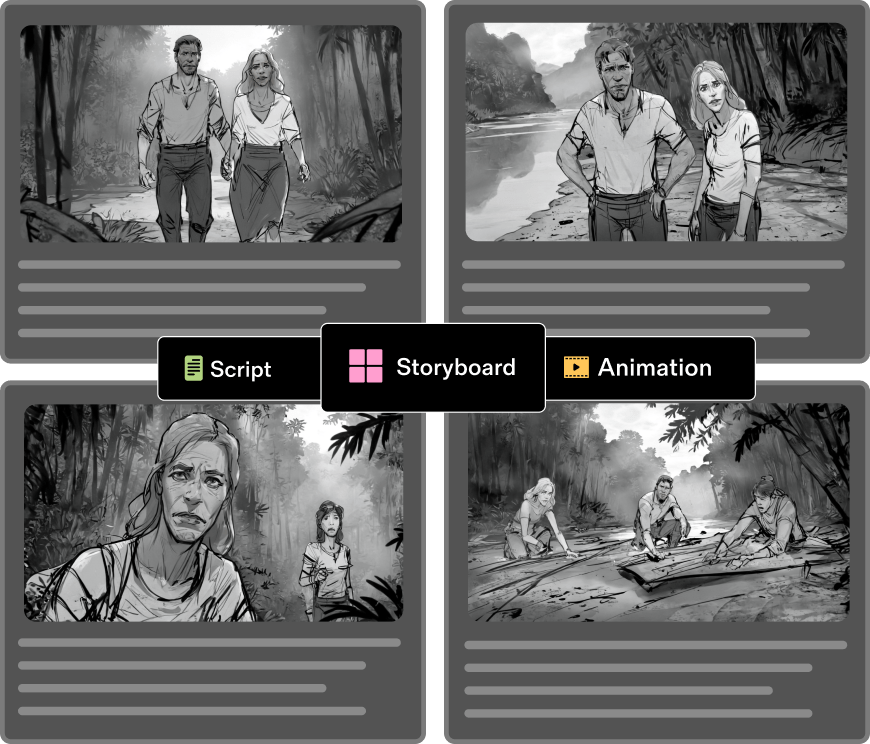



Directors use storyboards to map out the visual narrative, ensuring that the story unfolds seamlessly.

Animators turn to storyboards to grasp the sequence of events and maintain uniformity in character movements.

Producers rely on storyboards to organize resources, keeping the project on schedule and within budget.

Writers utilize storyboards to transform their scripts into visual scenes, making sure their story is depicted accurately on screen.

Editors leverage storyboards to plan out cuts and transitions, enhancing the storytelling flow.

Marketing and PR specialists use storyboards to design captivating promotional materials for animation projects.
Early 20th Century
1930s
1940s
1950s
1960s
1970s
1980s
1990s
2000s
2010s-Present



.jpg)

Turning a written script into a visual format can be daunting. Storyboarding helps the team visualize scenes, making it easier to grasp the narrative flow and pacing of the story.

Correct timing and pacing are essential in animation. Storyboards allow creators to map out each scene's timing and adjust the pacing to keep viewers engaged and convey the story effectively.

Maintaining continuity and consistency in character actions, settings, and visual style is challenging. Storyboards provide a visual reference that ensures these elements remain consistent throughout the production.

Conveying complex visual ideas to a team can be difficult. Storyboards serve as a common visual language, facilitating better communication and collaboration among team members.

Detecting potential problems with the narrative, shot composition, or scene transitions early on can be tough. Storyboarding helps identify and resolve these issues early in the production process, saving time and resources.

Finding the best way to frame shots and compose scenes can be challenging. Storyboards allow artists to experiment with different compositions and framing techniques before finalizing animations.

Effective planning and resource allocation are crucial in film production. Storyboards help producers and directors visualize the scope of each scene, making it easier to allocate time, budget, and manpower efficiently.

Animating complex action sequences or intricate movements without a clear plan can be difficult. Storyboards break these sequences into manageable parts, providing a clear roadmap for animators.

Securing approval from clients or stakeholders can be time-consuming. Storyboards offer a visual representation of the project, making it easier for clients and stakeholders to understand the vision and provide feedback before animation begins.

Experimenting with different ideas and concepts can be risky and time-consuming. Storyboards allow creators to quickly sketch and test various ideas, enabling exploration of creative options without significant investment of time and resources.
Addressing these challenges with effective storyboarding can streamline the film production process, enhance communication, ensure consistency, and ultimately result in a more polished and impactful final product.
Get Started for Free

Visit Katalist.ai to sign up and embark on your journey to seamless storyboarding.
Get Started for Free







By following these steps, you can efficiently create detailed, professional storyboards that enhance your animation project, streamline your workflow, and foster creative collaboration.
Get Started for Free


Generate complete, professional-level scripts from a description or an idea. Say goodbye to writer’s block.

Import your scripts in various formats, including FDX, CSV, PDF, or DOCX. We’ve got you covered.

Automatically convert your scripts into detailed storyboards, saving time and ensuring accuracy.

Maintain continuity with automated tools that ensure consistent character designs and scene layouts.

Upload a single photo of a character, and Katalist will transform it into your main character with one click.

Collaborate in real-time with your team, sharing and editing storyboards seamlessly.

Control camera angles, shots, and poses to create a visual story that fits your ultimate vision.
Transform your film production workflow with Katalist AI, the ultimate solution for storyboarding. Discover how our platform revolutionizes the storyboarding process, making it more efficient, creative, and collaborative.
Get Started for Free